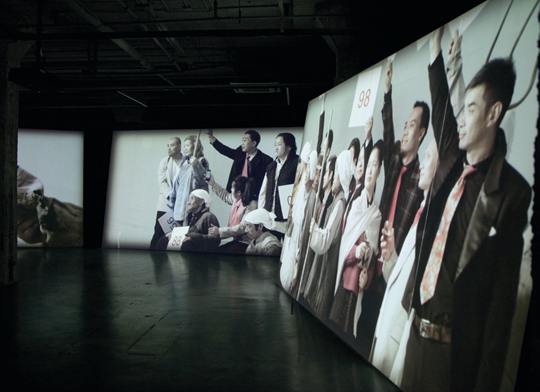PRESENT·BEING — THE VIDEO WORKS OF WANG GONGXIN OVER 20 YEARS
| May 22, 2015 | Post In LEAP 32

It’s been 20 years since Beijing-born artist Wang Gongxin returned to China after a decade in Williamsburg, bringing with him fresh ideas about new media and video art. He first responded to his repatriation by digging a hole in the floor of his hutong home and placing in it a video monitor playing Sky of Brooklyn (1994), so that viewers had the sensation of looking through the floor to the other end of the world. Of course, this work is an inversion of the American phraseology “digging a hole to China,” and, in many ways, it anticipated today’s art world, where east and west are intimately interconnected.
In his exhibition at OCAT in Shanghai, “Present-Being,” Wang Gongxin presents documentation of Sky of Brooklyn through a series of black-and-white still photographs that evoke a time when new media was new, but also quite primitive—where the sky itself could only be captured in shades of grey, rather than bright blue. He contrasts this documentation of his first experiment with video with his most recent creations, which are startlingly precise, full of vivid detail with an intentionally muted color range. The leap in technology is simultaneously exciting and scary; it is not surprising that an artist whose life embodies those changes and permutations should take this moment to look back and reflect on what is left of his past, and what aspects of history continue to make an impact on his work. Each of three multi-channel video works on mural-sized screens is inspired by a historic work of art, reinterpretations that comment on the efficacy and endurance of certain pictures even in an age when the overproduction of images has severely undercut their power to persuade.
In Courbet’s The Artist’s Studio (1854-55), the artist is seen painting a landscape, ignoring the nude model at his side and avoiding the distractions created by crowds filling the space to watch him work. In Wang’s Whose Studio (2015), a group of nude women, artists’ models from the Central Academy of Fine Arts, fill one screen at the center of the installation, boldly confronting viewers without shame. They are joined by other sectors of Chinese citizenry—construction workers, office managers, hipsters, and peasants—each filling a screen with haunting faces and awkward bodies. Taken as a whole, it is a sociological study by a contemporary artist, and proof that video makes reality more real.
In Bloodstained Auction (2015), Wang Gongxin relies on the configuration of crowds depicted in Wang Shikou’s classic revolutionary painting, Bloodstained Shirt, to frame his most contemporary view of an art auction. In the painting, a crowd of peasants brings their grievances with a landlord before a group of Communist soldiers; in the video interpretation, a crowd of businessmen and women raise their arms to bid as an elegant lady waves a bright red garment. Glasses of red liquid—blood or wine?—fill and spill over, flooding a table. It is easy to see this as the grief caused by the auction rooms to the living artist, the damage caused by the commercialization of art.
Least effective is Wang Gongxin’s The Story of Lei Feng (2015), in which the artist captures a series of readers engaged with books or tablets and smartphones. The complexity of the Lei Feng propaganda mythology is not quite captured in the reenactments, though many will recognize the protagonist’s pose—reading a revolutionary text—from the widely circulated photograph, now more often seen as Communist kitsch. This work may not be as moving to younger viewers who did not grow up with endless exposure to the Cultural Revolutionary iconography of Wang’s generation, but this should not detract from the accomplishment of the exhibition, which captures the tone and anxieties of present-day China even without knowledge of its past.
Some will interpret Wang’s installations as commentary on the guises that realism has taken throughout the modern era, from pre-Impressionist painting to Revolutionary history painting and finally to current digital technology able to capture every pore on a subject’s face. But, in this age of post-Photoshop simulacra, it is better to view these works as hyper-realistic fictions, the consummate creations of a masterful artist.

